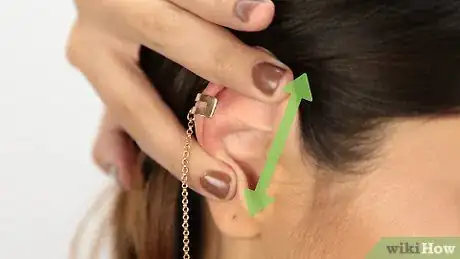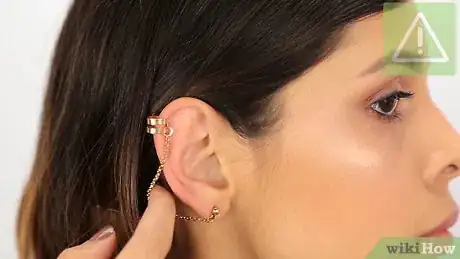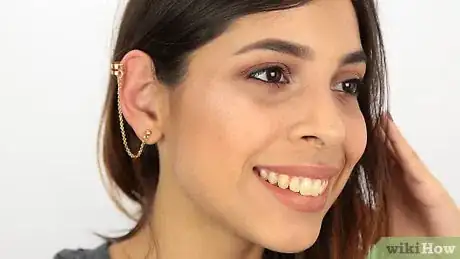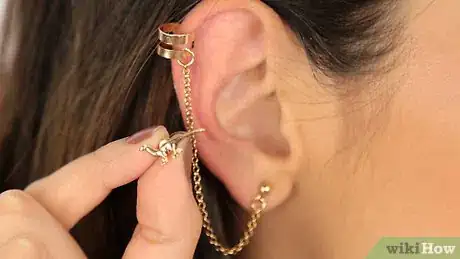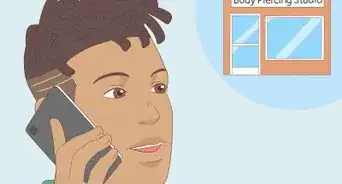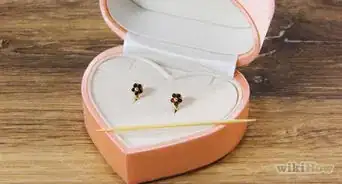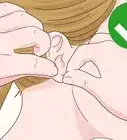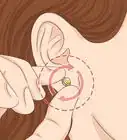wikiHow is a “wiki,” similar to Wikipedia, which means that many of our articles are co-written by multiple authors. To create this article, volunteer authors worked to edit and improve it over time.
The wikiHow Video Team also followed the article's instructions and verified that they work.
This article has been viewed 276,607 times.
Learn more...
Ear cuffs are a popular trend in funky, chic jewelry. Best of all, most ear cuffs can be worn regardless of whether or not your ears are pierced.
Steps
Placing the Ear Cuff
-
1Slip the cuff onto the upper ear in front of a mirror. Locate the thinnest section of cartilage along the upper portion of your ear and slip the opening of the cuff around it.[1]
- One side of the cuff flange should be behind the ear. The other side should be on the front.
- Until you get used to the way a correctly positioned cuff sits on your ear, it will be easiest to put the cuff on while looking at your ear in a mirror.
-
2Hold the ear taut. Use one hand to hold the skin and cartilage of the ear taut. Doing so can make it easier to slide the cuff into place.
- It is often easiest to use whichever hand is located on the same side of the body as the ear you're working on. When putting a cuff on your left ear, use your left hand to hold the ear taut. When working with the right ear, use your right hand.
- Pinch the top of the ear just above the cuff in place using your index and middle fingers. Pinch the earlobe in place using your thumb and ring finger.
- Gently tug the top and bottom of your ear in separate directions, causing the outer ridge of the ear to stretch just enough to become firm and taut.
Advertisement -
3Slide the cuff down and inward. Use your other hand to carefully slide the ear cuff down the outer rim of cartilage. Rotate the cuff as you slide it down so that it leans in slightly toward the inner ear, eventually settling along inside the hollow portion at the outside of the ear canal.
- Only the front flange should settle on this inner portion of the ear. The cuff itself needs to wrap around the rim of the ear, and the back flange should remain completely behind the ear.
- Most ear cuffs should be positioned just midway along the outer rim of the ear, just above the top of the earlobe.[2]
-
4Check the fit. The ear cuff should rest securely on the rim of the ear without pinching it.
- The ear cuff should be comfortable. If it makes your ear sore, it's too tight. If it starts slipping off or slipping further down your ear, it's too loose.
-
5Make subtle adjustments by hand. Most ear cuffs are delicate enough for you to adjust by hand. Squeeze the opening in between your fingers to make it tighter. If you want to make the cuff looser, pry the opening apart wider with your fingers.
- Adjustments made with your fingers can be done while the ear cuff is on your ear, but you should work carefully and in slow increments to avoid misshaping the cuff or injuring your ear.
- When working with ornate wire ear cuffs, you may also need to adjust the angle of the cuff's decorative wiring with your fingers so that it matches the natural curvature of your ear.
-
6Remove the cuff before making major adjustments. Rigid ear cuffs should be adjusted with smooth needle nose pliers.
- Since you'll be applying more pressure, you should remove the cuff from your ear before making any adjustments to it. Doing so will allow you to make more precise alterations and should reduce the risk of accidental injury.
Positioning an Attached Earring
-
1Place the cuff portion on your ear. If you're working with ear cuffs that have a separate earring attached with a chain, you need to position the ear cuff portion normally before you can put in the earring portion.
- If the ear cuff does not have an earring attached by a chain, this section can be skipped.
-
2Slip in the post. Insert the earring post through the piercing in your earlobe as you would do with a normal earring. If the post has a backing, fit the backing onto it from behind your earlobe.
-
3Check the appearance and adjust as needed. Take a look at the ear cuff in a mirror. If the chain is too taut, slide the cuff further down the side of your ear.
- Similarly, if the chain sags too much, you can adjust it by sliding the cuff further up along the outer ridge of the ear.
- Make sure that the chain is not twisted around the earring and that it falls to the outside of the cuff and earring. Use your fingers to make any necessary adjustments.
Style Considerations
-
1Try different cuff styles. Ear cuffs come in a variety of styles, so you'll have plenty to choose from when you go shopping.[3]
- The simplest ear cuffs are dainty hoops that wrap around the ridge of the ear without any further adornment. These hoops can be made of light wire, heavy wire, or solid metal.
- Some hoop ear cuffs have a separate earring piece attached by a thin chain or series of chains. This earring should be placed into an earlobe piercing.
- Other ear cuffs can be more ornate. The cuff itself rests in the hollow of the ear (as described in the "Placing the Ear Cuff" section), but the decorative part is meant to encircle the outer curve of the ear. This decorative portion can be made of dainty wire or solid metal. Some ear cuffs are even studded with gems or similar elements.
-
2Go for an unbalanced look. Wear an ear cuff on one ear instead of wearing them on both. The look is supposed to be edgy and asymmetrical.[4]
- Even small ear cuffs stand out, so weighing both ears down with cuffs can make your overall look seem heavy and cluttered.
- You should only wear ear cuffs on one ear at a time, but the ear you choose does not matter.
-
3Wear the cuffs with your favorite earrings. If you can't choose between your favorite pair of earrings and your favorite ear cuffs, you might be able to wear both.
- When you take this option, though, it's best to keep one or both elements fairly subdued.
- For instance, you could wear simple diamond stud earrings with a decorative cuff, especially if the cuff has an open space in its design to accommodate an earring. Another option would be to wear a pair of long dangling earrings with a simple wire hoop cuff.
- You should not, however, wear an elaborately designed ear cuff with heavy dangling earrings. The two pieces will likely clash and create too much weight.
-
4Balance it with the rest of your jewelry. Simple ear cuffs can be worn with other jewelry, but more elaborate cuffs often look best when they don't have to compete with other large statement pieces.
- Like earrings, other jewelry you wear—necklaces, bracelets, rings—should balance out the ear cuff instead of competing with it. An ornate statement necklace can be worn when you have simple hoop ear cuffs, but when you have a more elaborate cuff, you should stick with things like small pendant necklaces or plain dangle bracelets when you choose anything at all.
-
5Show it off. Ear cuffs are meant to be worn as statement jewelry, but in order for them to make a statement, they have to be visible.
- Tie your hair back or arrange it in a messy bun.
- Consider putting a deep side part in your hair so that the side with the cuff is more exposed.
- If nothing else, you should at least expose the ear cuff by sweeping your hair behind your ear.
Community Q&A
-
QuestionHow long am I able to wear the ear cuff? Can I wear it overnight, every day?
 Community AnswerIt's not a good to wear overnight, eventually it could cut off some blood flow or make your ear irritated.
Community AnswerIt's not a good to wear overnight, eventually it could cut off some blood flow or make your ear irritated. -
QuestionIf I wear an ear cuff in one ear, what should I wear on the other ear?
 Community AnswerA small stud earring or a simple hoop. You can also just leave it bare. Asymmetry can be visually interesting.
Community AnswerA small stud earring or a simple hoop. You can also just leave it bare. Asymmetry can be visually interesting. -
QuestionI am 75 years old. Can I wear ear cuffs or wrappings?
 Community AnswerYour age doesn't really matter, as long as it feels comfortable. However, you should not keep it on overnight, as it may cut off blood flow.
Community AnswerYour age doesn't really matter, as long as it feels comfortable. However, you should not keep it on overnight, as it may cut off blood flow.
Things You'll Need
- Ear cuff
- Mirror
- Smooth needle nose pliers (optional)
References
About This Article
To wear an ear cuff, start by slipping the cuff onto your upper ear where it's thinnest. Then, hold your ear taut while you slide the cuff down the outer rim of cartilage, rotating the cuff so it leans in slightly toward your inner ear. Try to position the cuff midway down, just below the top of your earlobe. Then, settle the cuff inside the hollow part at the outside your ear canal, with the front of the cuff wrapped around the rim and the back completely behind your ear. Finally, tighten or loosen the cuff so it sits comfortably and without pinching. To learn how to wear an ear cuff with an attached earring, scroll down!
